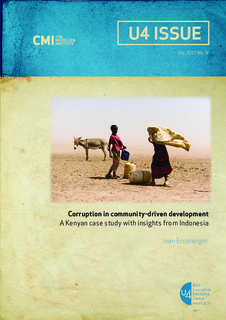| dc.contributor.author | Ensminger, Jean | |
| dc.date.accessioned | 2018-01-04T08:23:20Z | |
| dc.date.available | 2018-01-04T08:23:20Z | |
| dc.date.issued | 2017-07-01 | |
| dc.identifier | oai:www.cmi.no:6291 | |
| dc.identifier.citation | Bergen: Chr. Michelsen Institute (U4 Issue 2017:9) 60 p | |
| dc.identifier.uri | http://hdl.handle.net/11250/2475402 | |
| dc.description.abstract | Abstract
Community-driven development is a widely employed development strategy for empowering people to choose their own development priorities, to select their own project leaders, and to monitor the implementation of their projects. It is often assumed that this model results in lower corruption rates. In this paper we take a look at two such projects, the Arid Lands Project in Kenya and the KDP/PNPM project in Indonesia. These projects had strikingly different corruption rates, even though the countries in which they operated had similar corruption perception rates at the beginning of the projects. The goal of this paper is to highlight the specific design elements that may account for the different rates of corruption in these two projects.
Main points
by Professor Jean Ensminger , California Institute of Technology
Community-driven development is a widely employed development strategy for empowering people to choose their own development priorities, to select their own project leaders, and to monitor the implementation of their projects. One aim of CDD is to lower the level of corruption by increasing monitoring through community participation. Realizing this aim relies on two key assumptions. First, CDD is supposed to be more transparent than alternative development models due to reduced information asymmetries between beneficiaries and project staff. Second, villagers should be actively engaged and monitor the performance of those to whom they have delegated these responsibilities.
This new U4 issue paper examines two CDD projects, the Arid Lands Project in Kenya and the KDP/PNPM project in Indonesia. These projects had strikingly different corruption rates, even though the countries in which they operated had similar corruption perception rates at the beginning of the projects. This paper examines the project design differences that may explain this variation. The Kenyan villagers consistently confronted a wall of silence rega | |
| dc.language.iso | eng | |
| dc.relation | U4 Issue | |
| dc.relation | 2017:9 | |
| dc.relation.ispartof | U4 Issue | |
| dc.relation.ispartofseries | U4 Issue 2017:9 | |
| dc.relation.uri | https://www.cmi.no/publications/6291-corruption-in-community-driven-development | |
| dc.subject | Evaluation Measurement | |
| dc.subject | Community-Driven Development | |
| dc.subject | Corruption | |
| dc.subject | Monitoring and Evaluation | |
| dc.subject | Project Design | |
| dc.subject | Kenya | |
| dc.subject | Indonesia | |
| dc.title | Corruption in community-driven development. A Kenyan case study with insights from Indonesia | |
| dc.type | Research report | |
